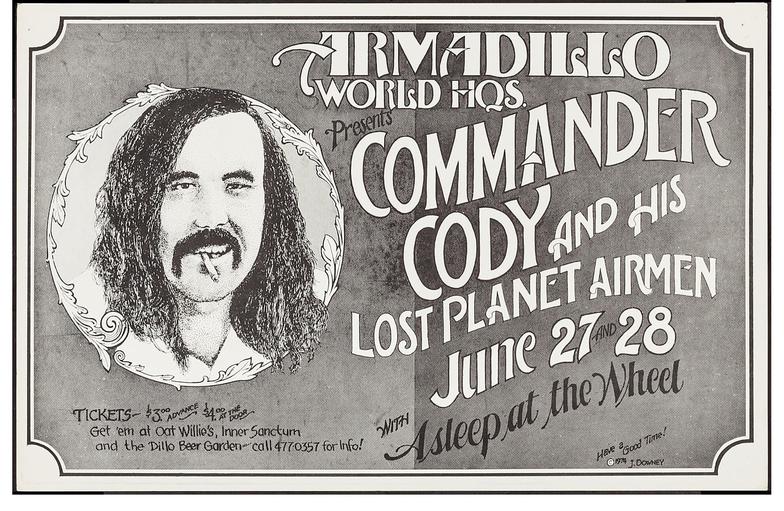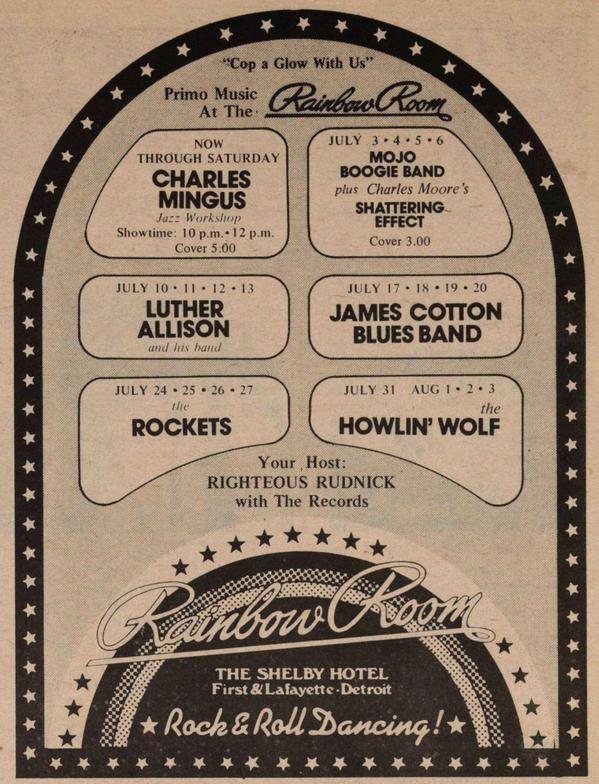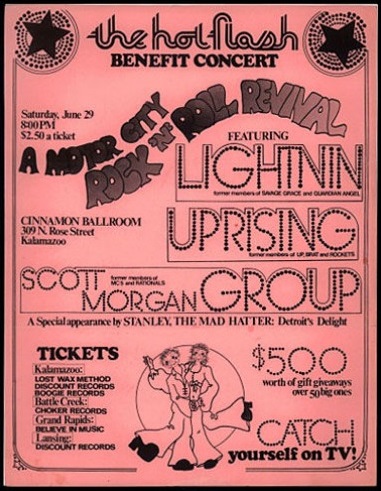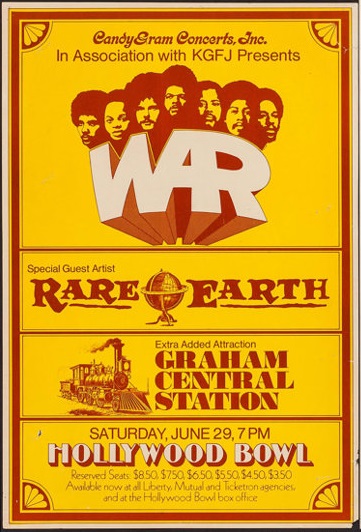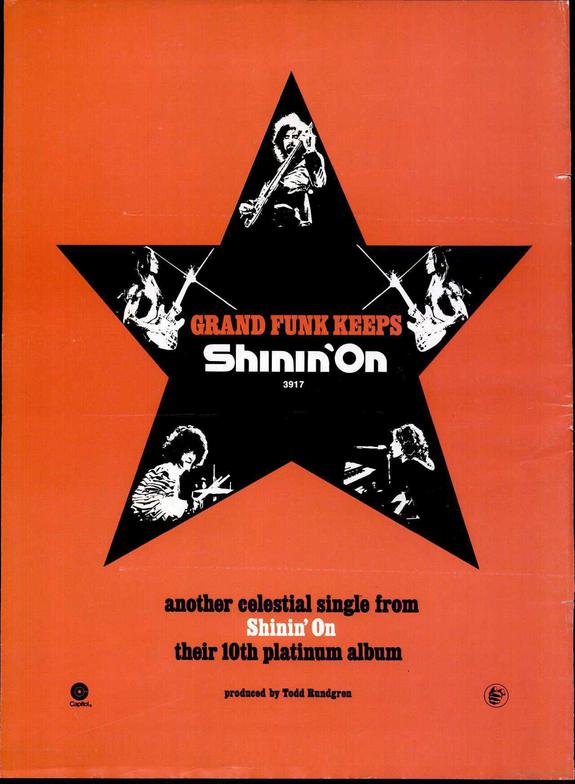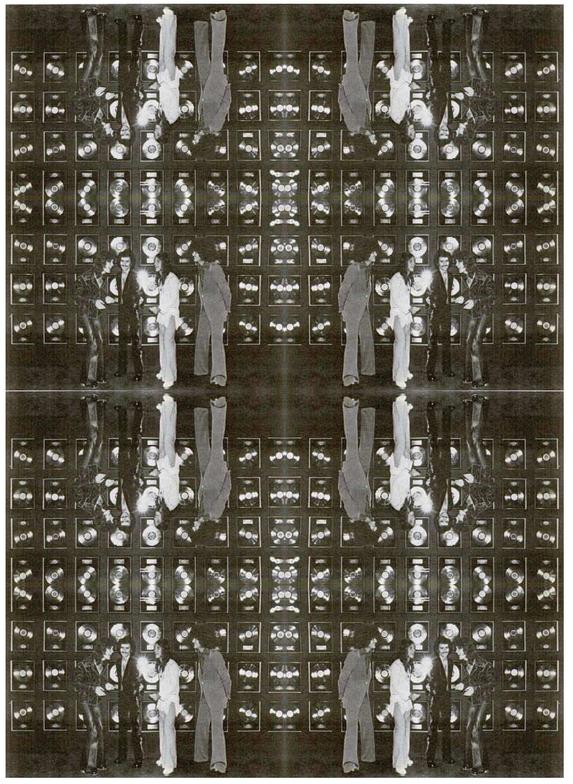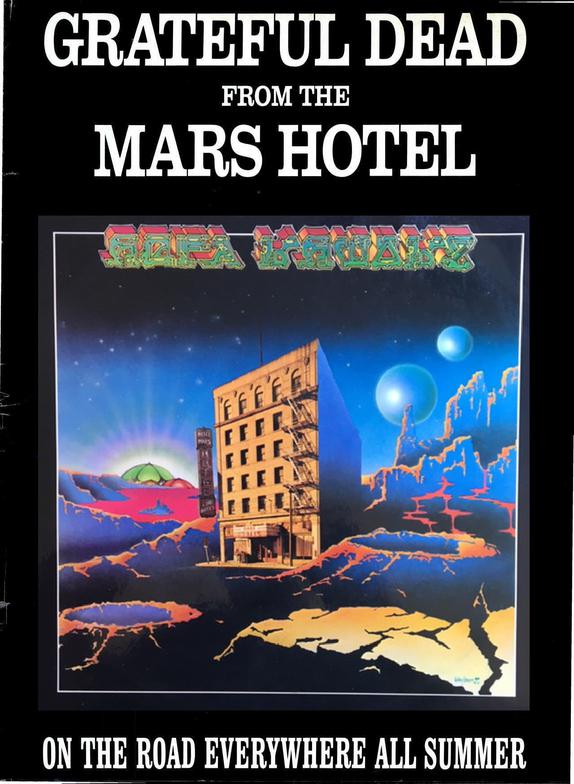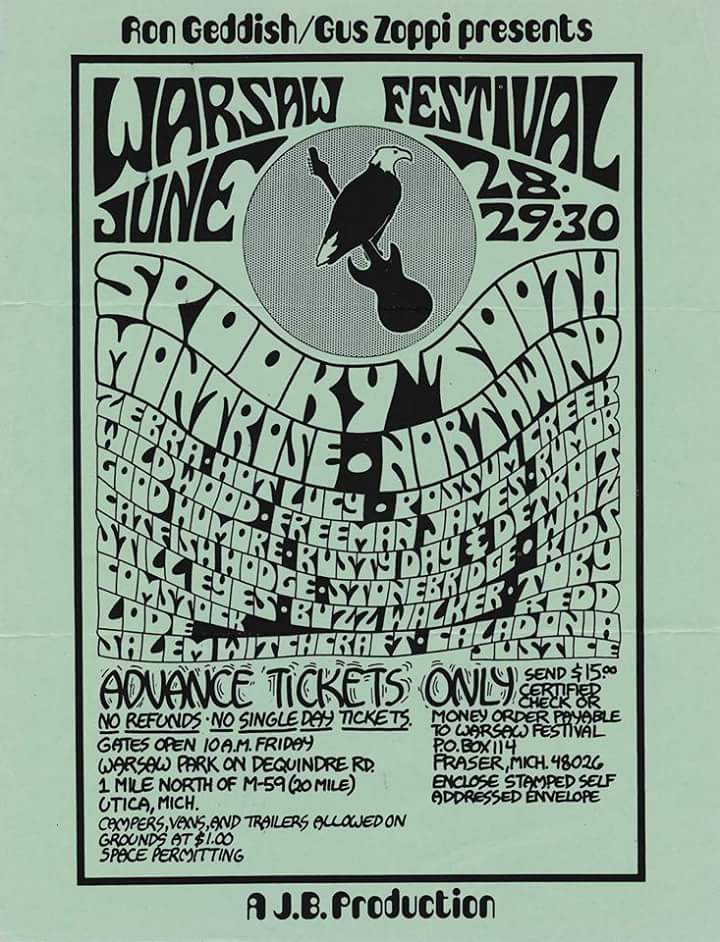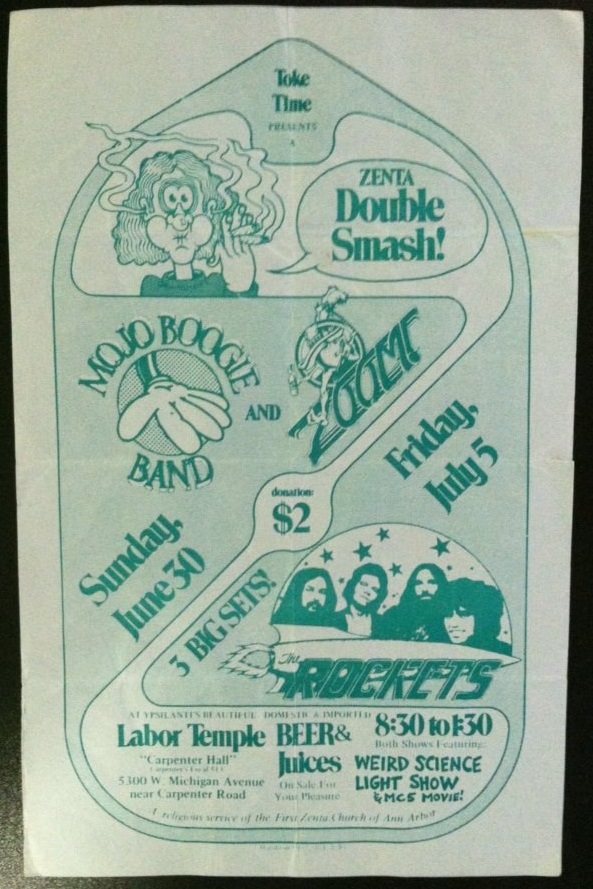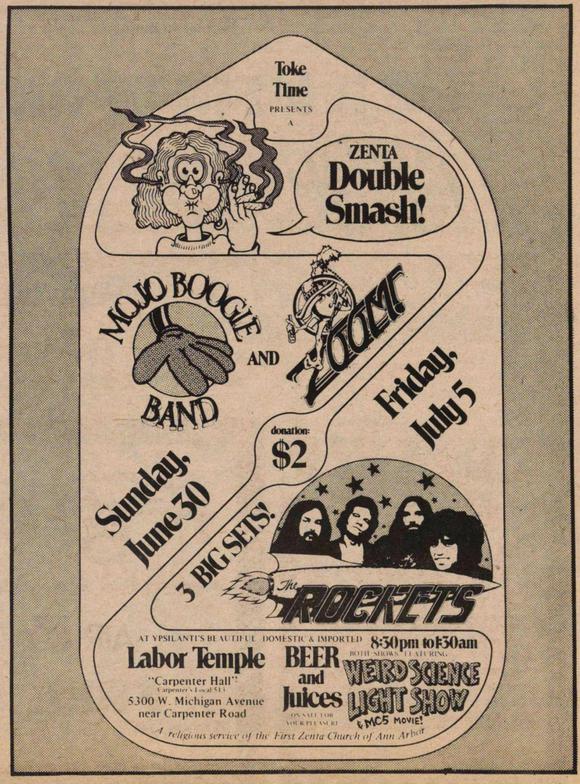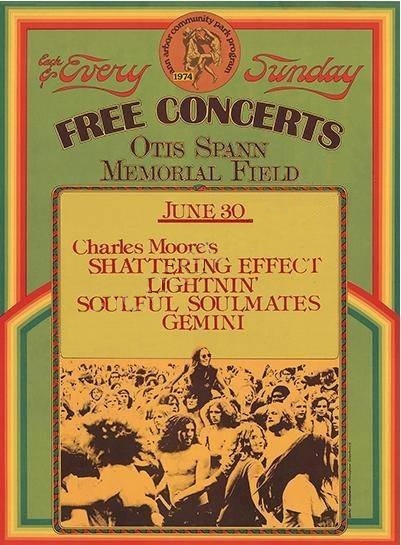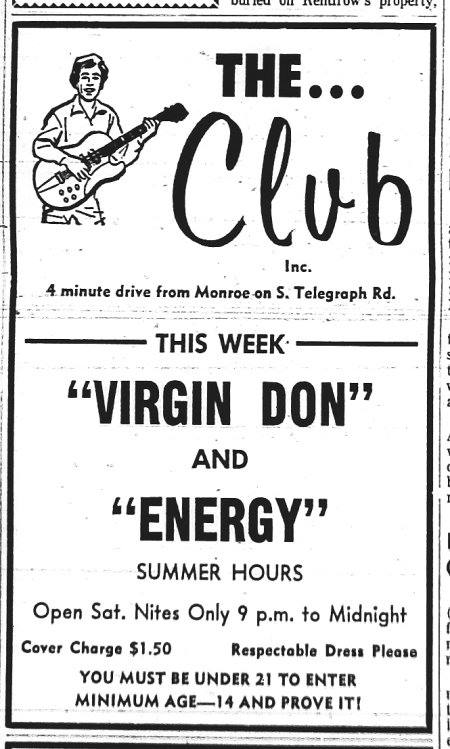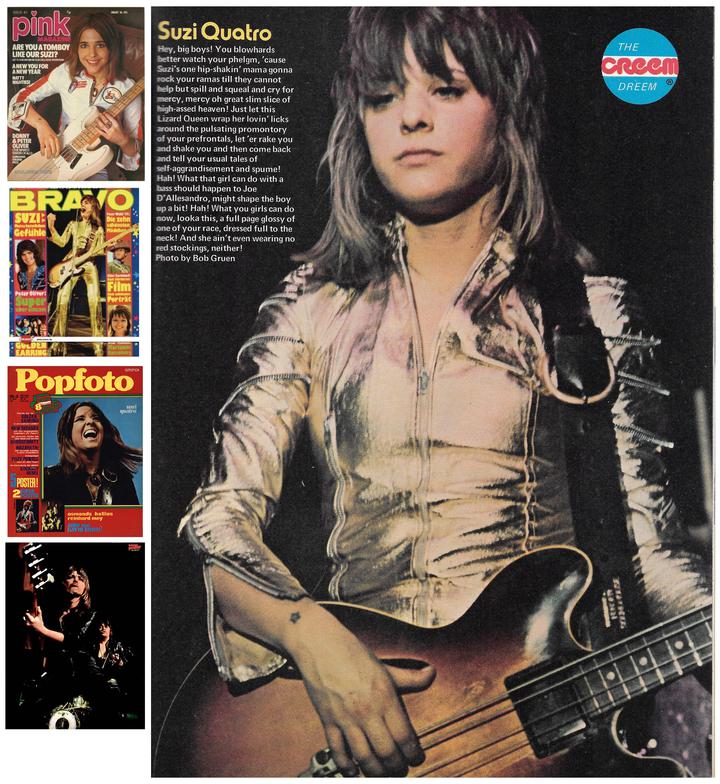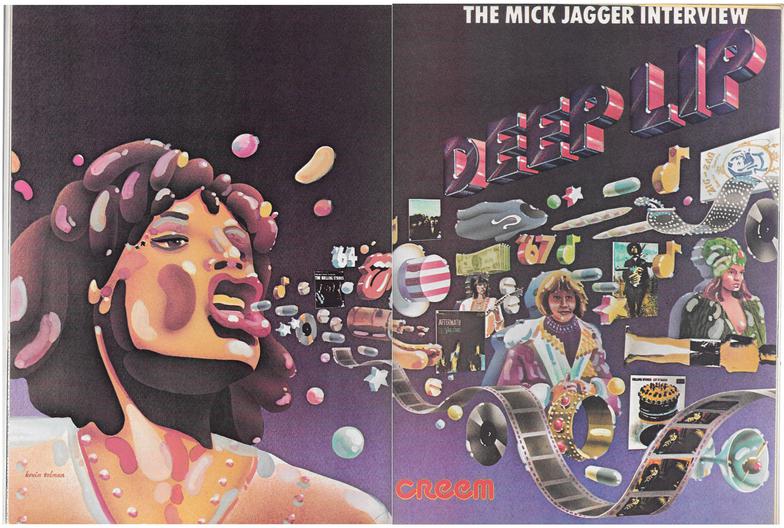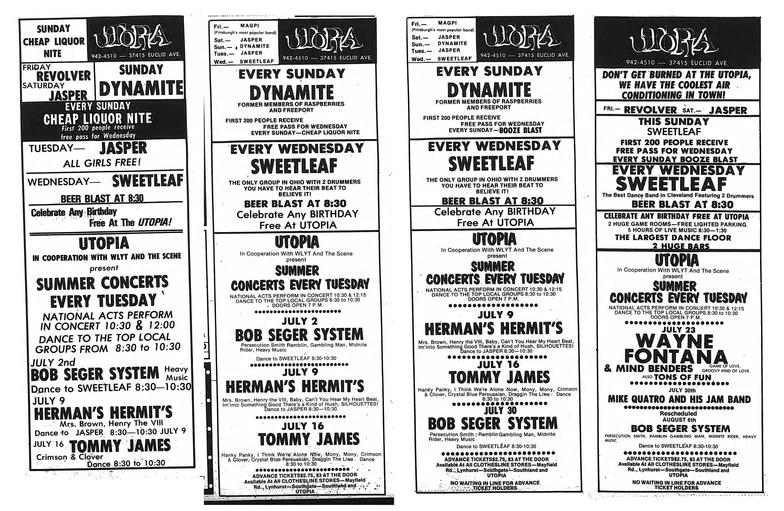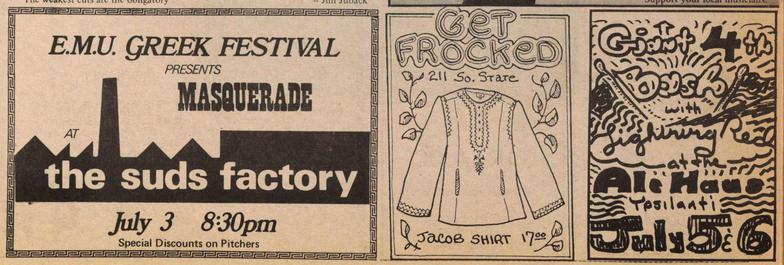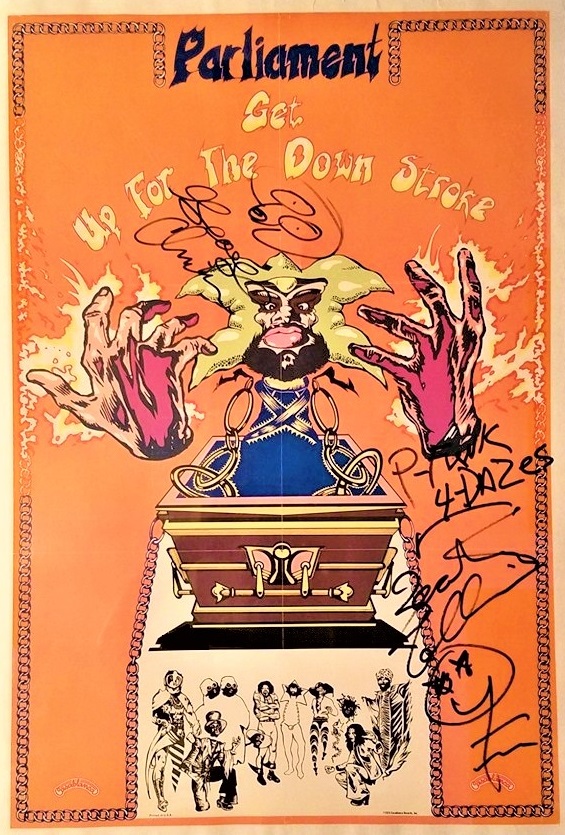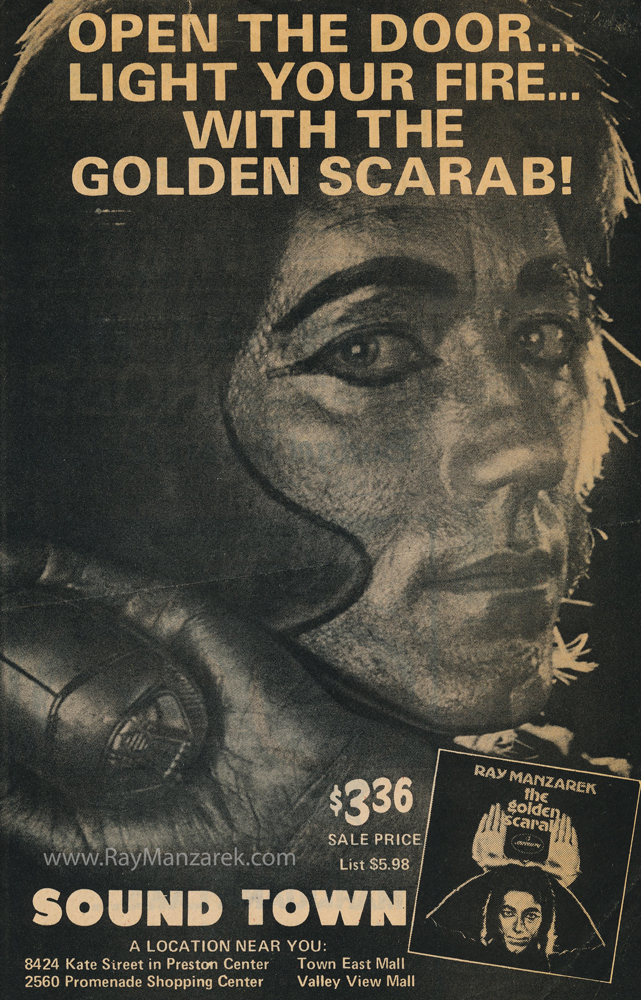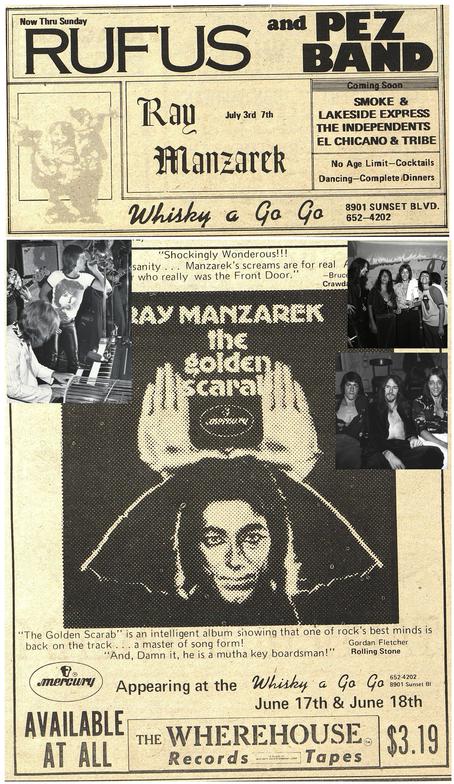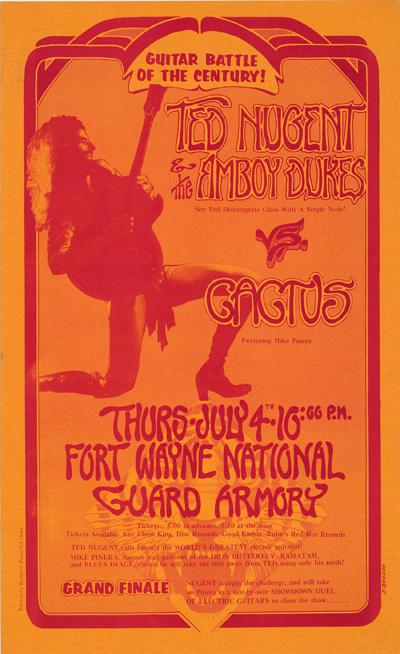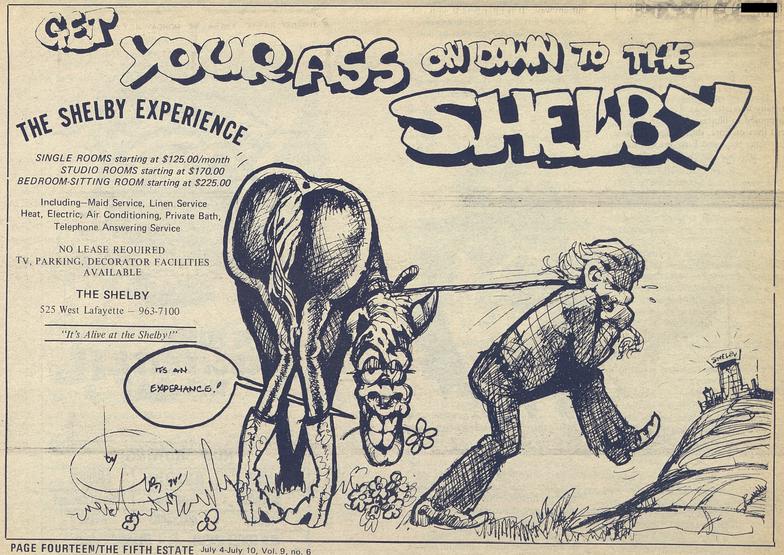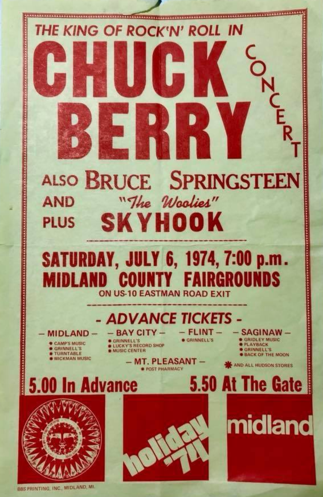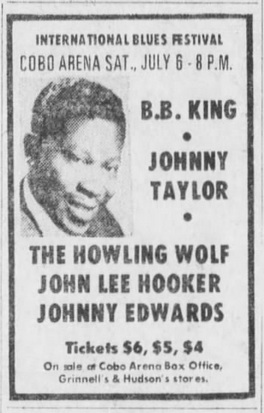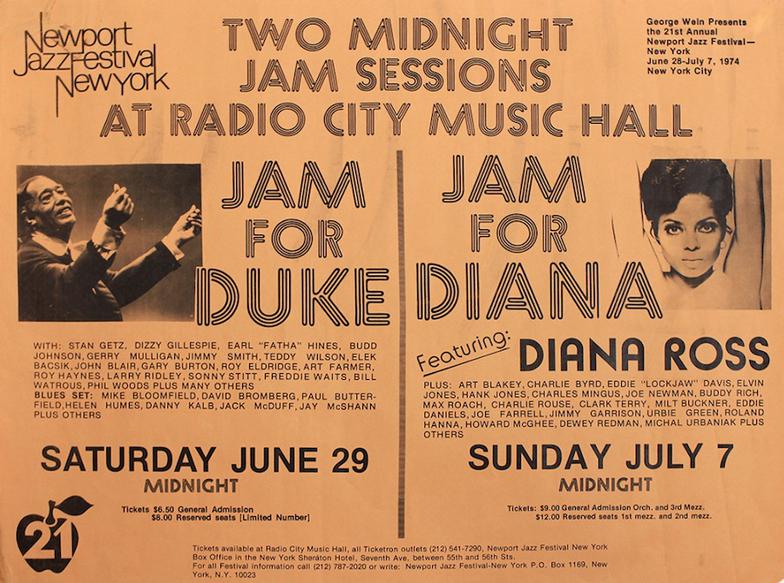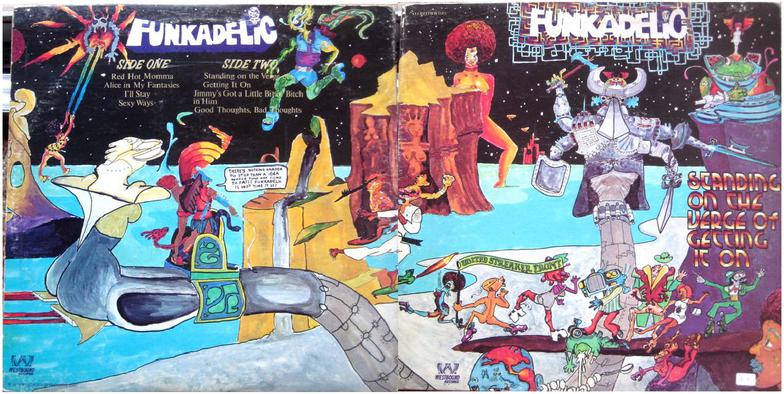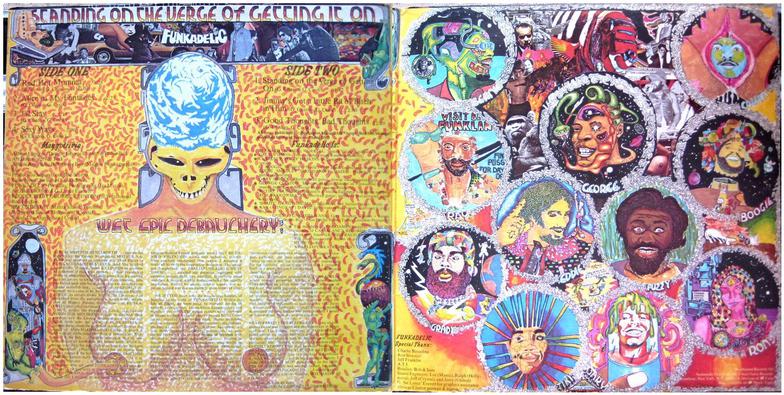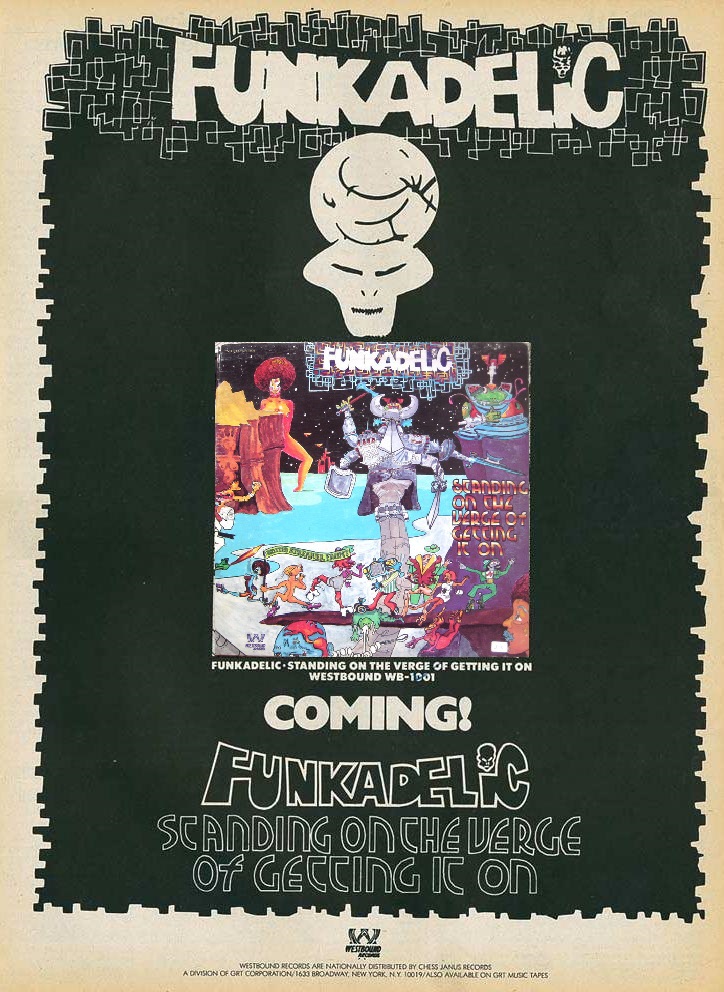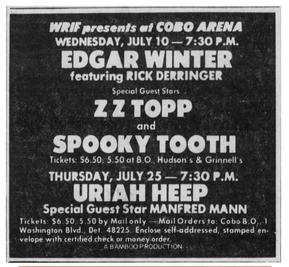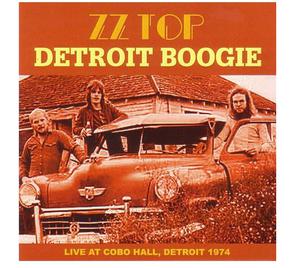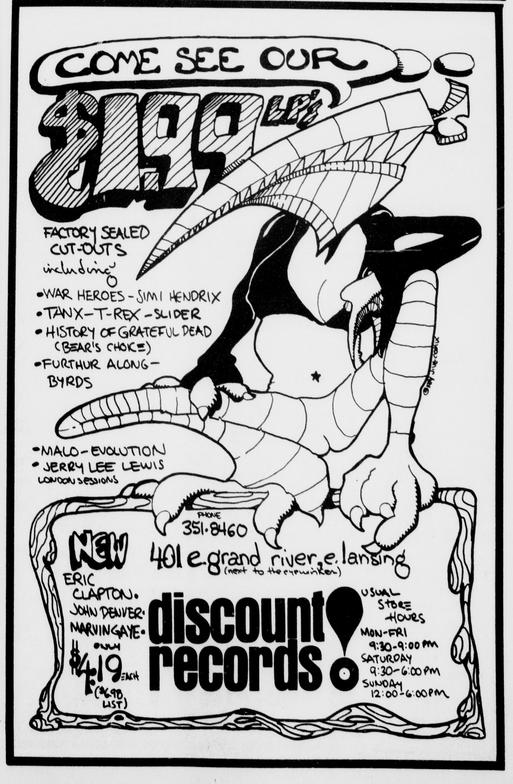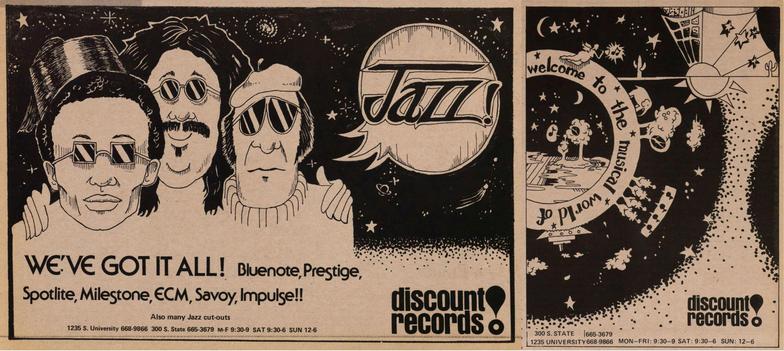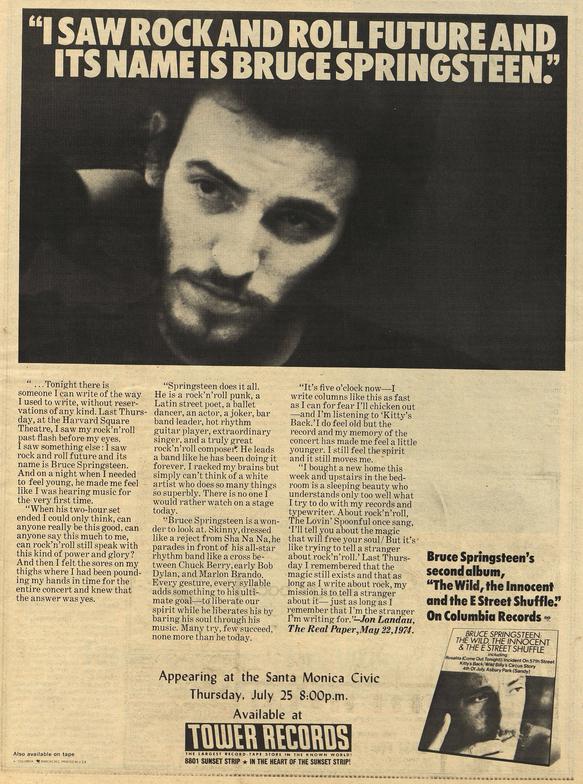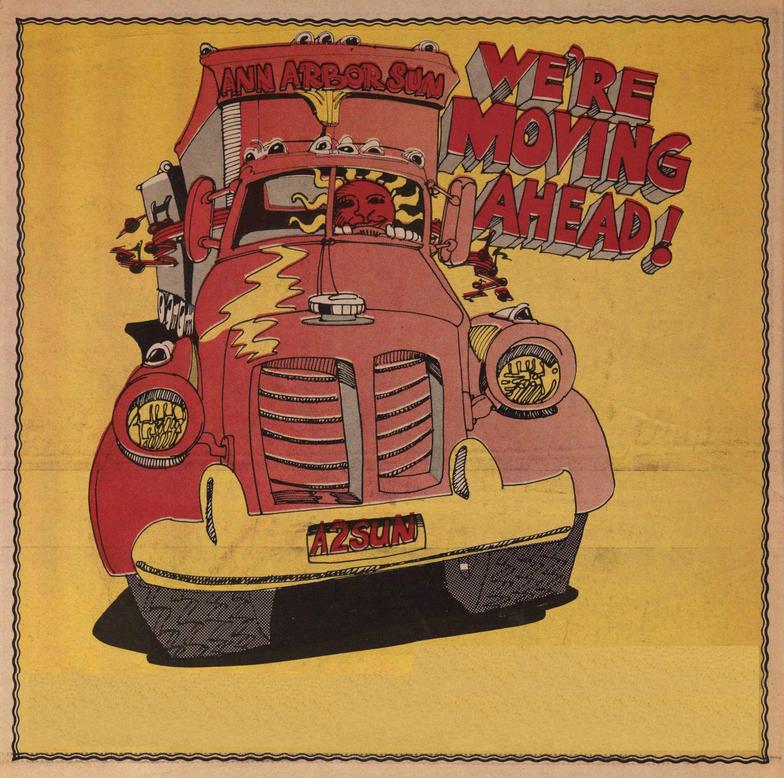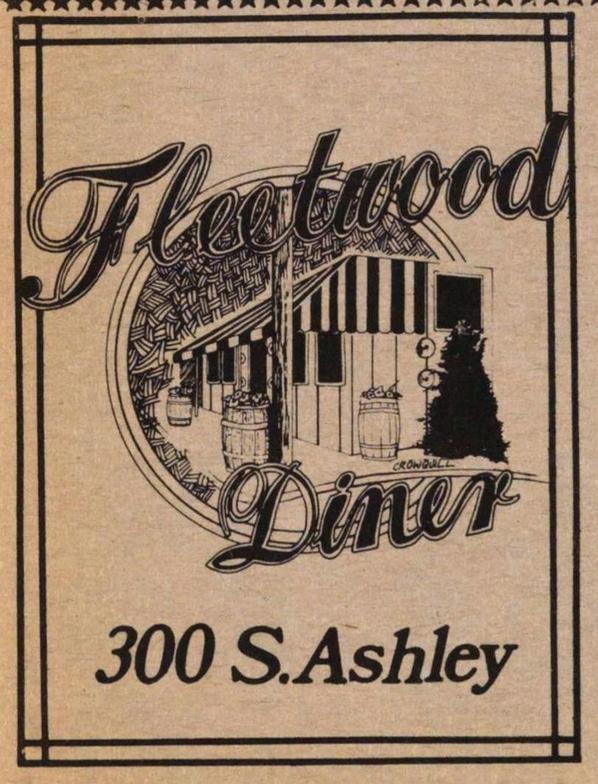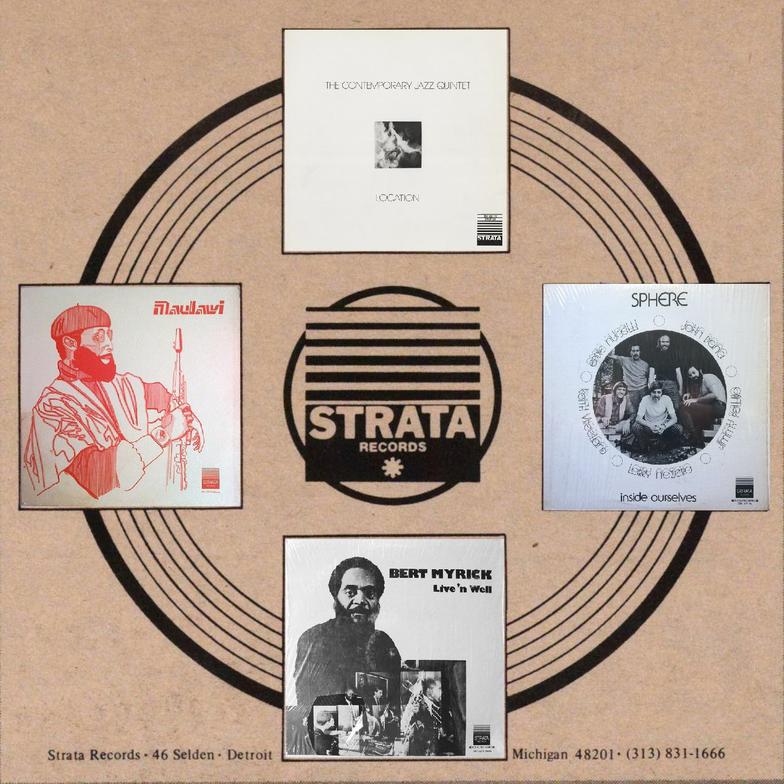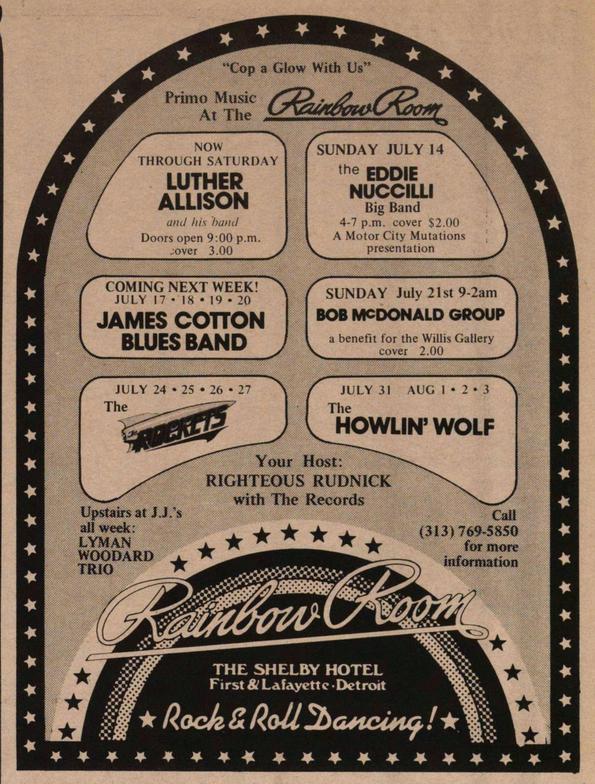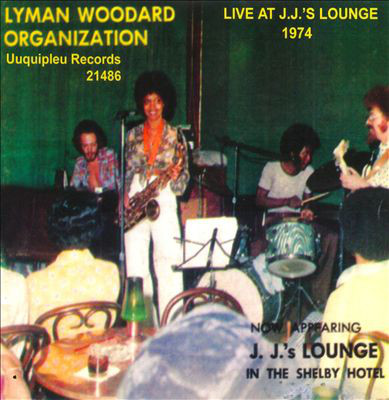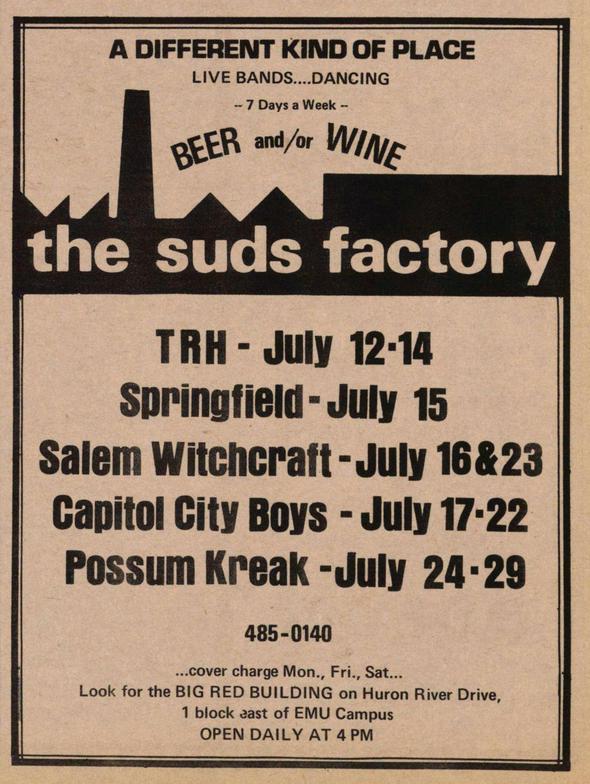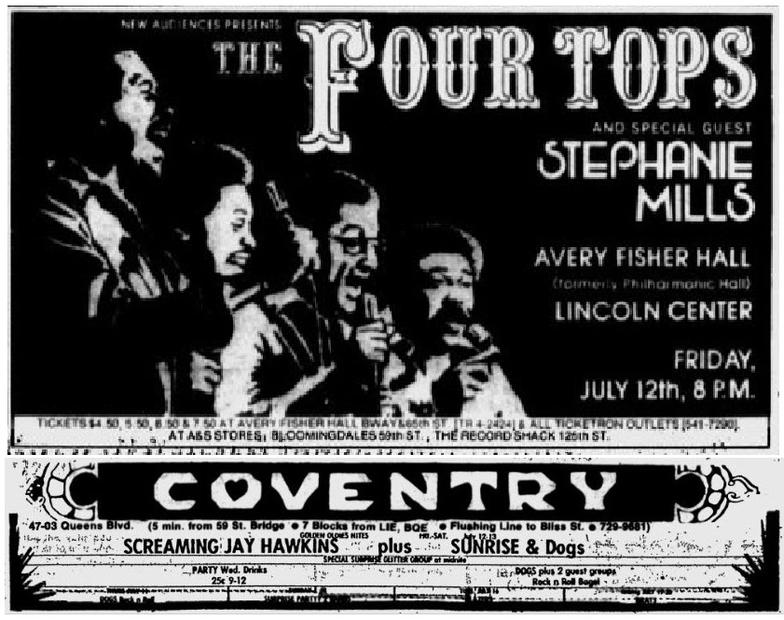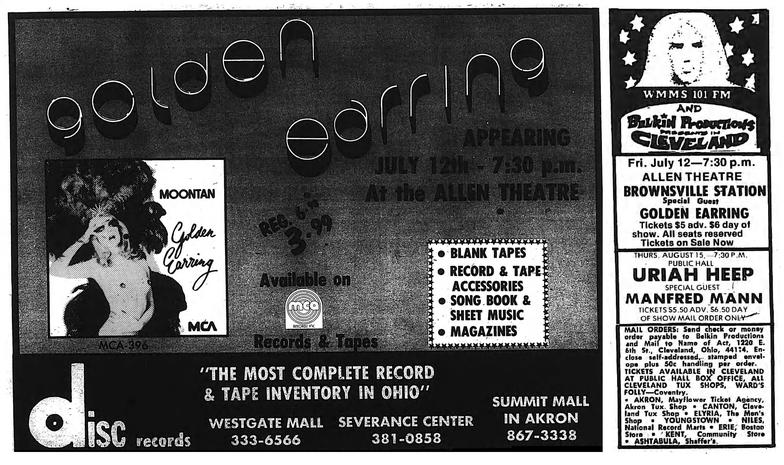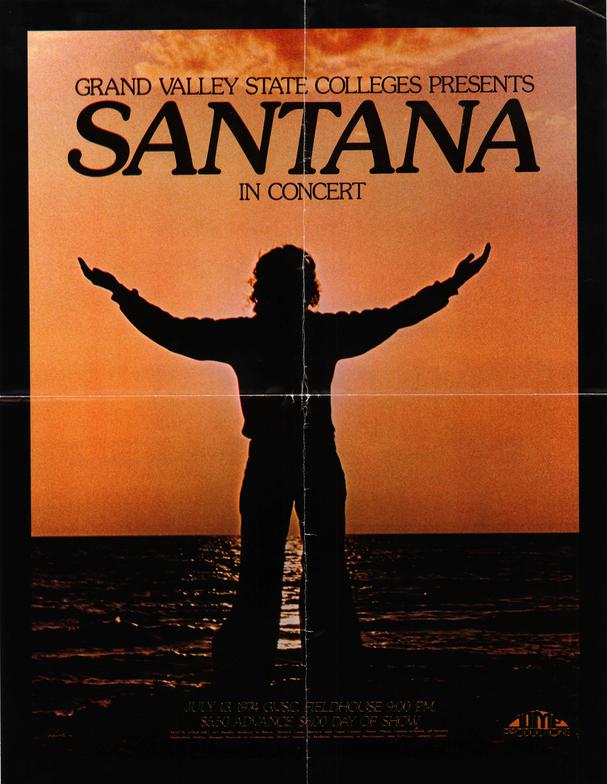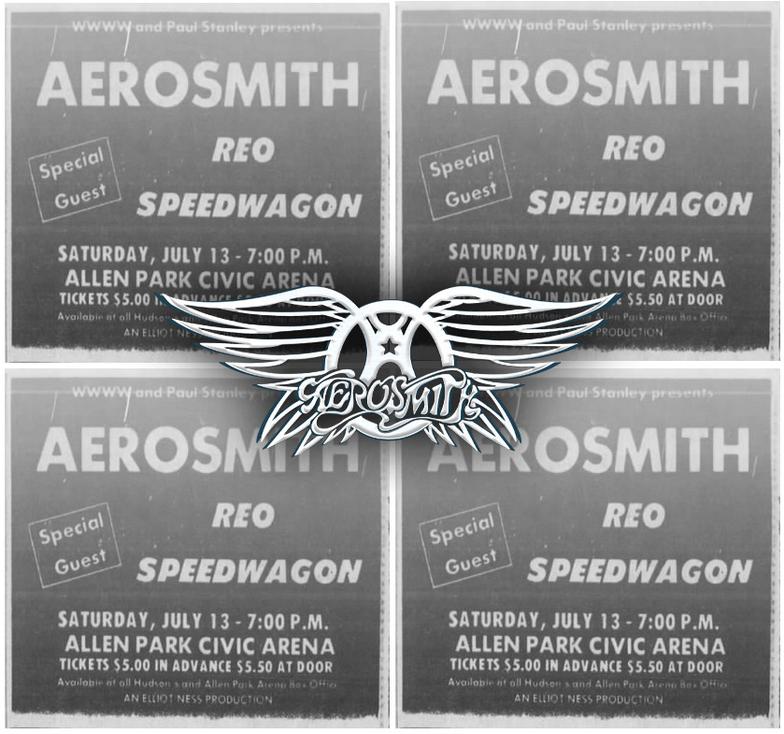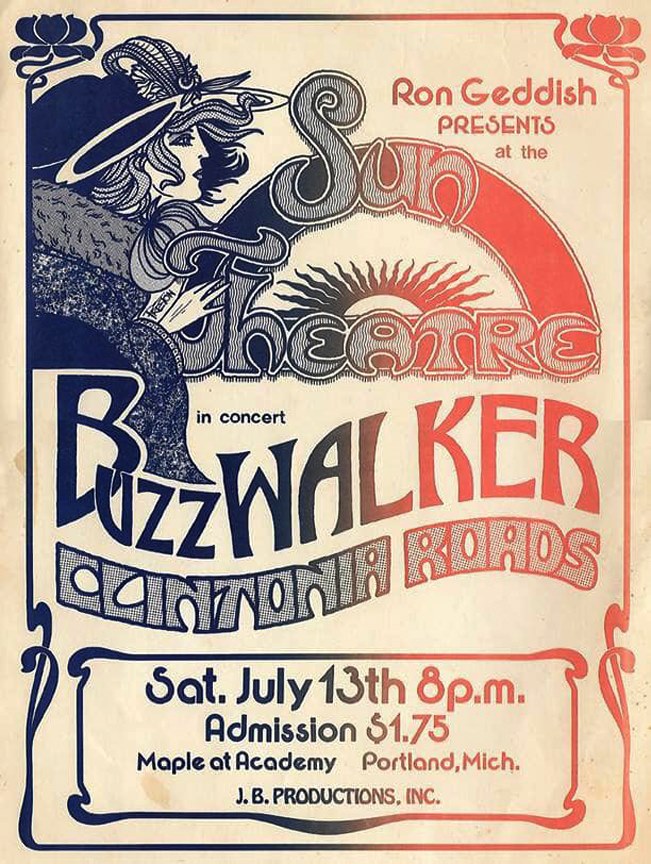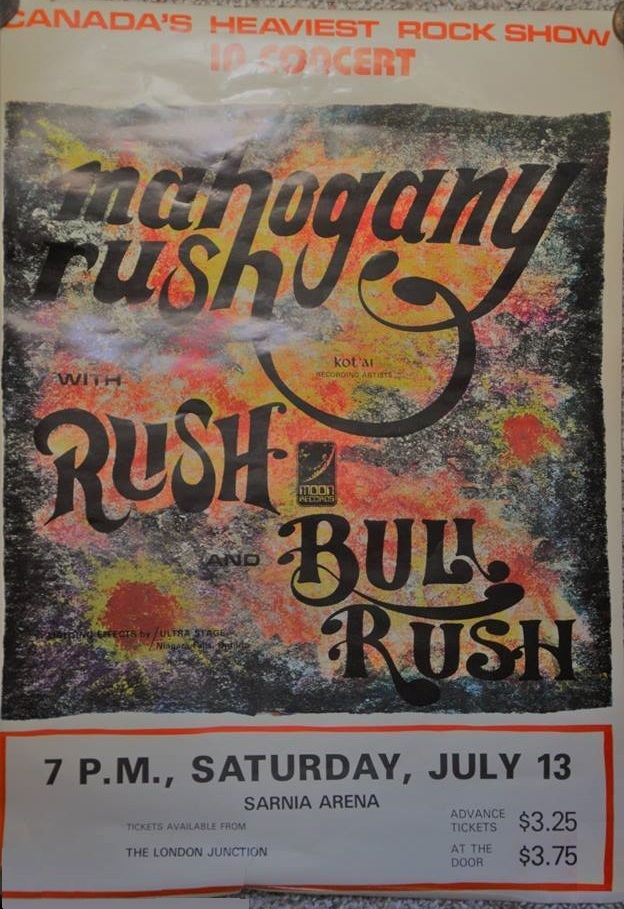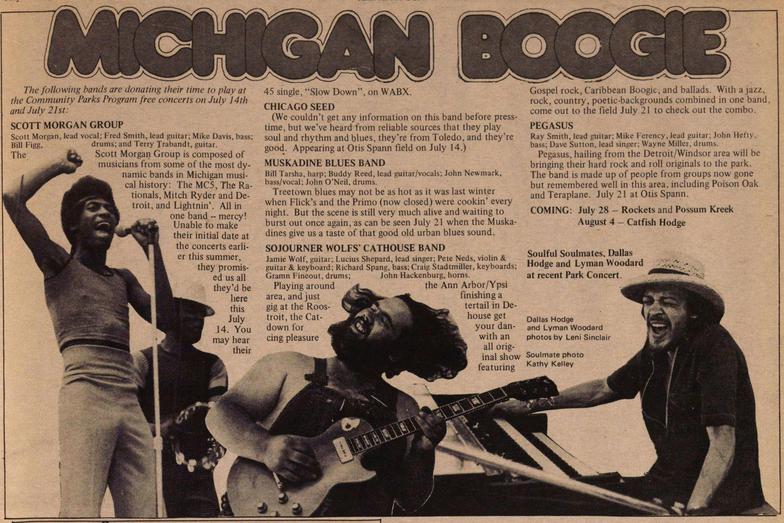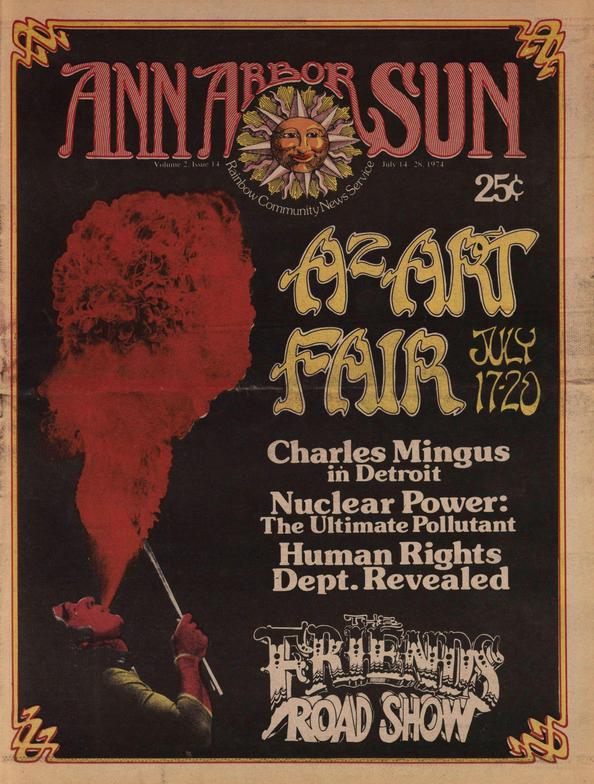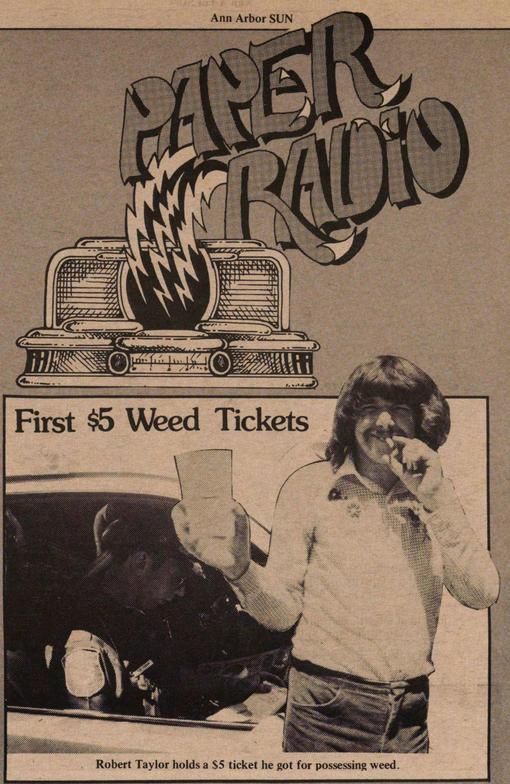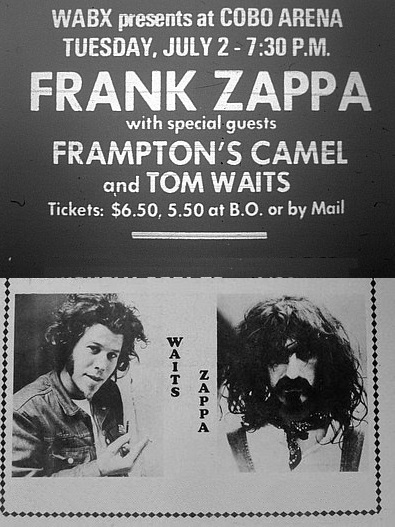Splatt Gallery
Double click here to add text.
Splatt Gallery's History of Michigan Music Posters
Volume Ten - 1974 - Page Eleven
************************************************************
Poster by J. Downey for Commander Cody & his Lost Planet Airmen at the Armadillo World Headquarters in Austin, Texas, June 27-28, 1974.
Ad for the Rainbow Room in the Shelby Hotel in Detroit, Michigan, with the schedule of events for June 28 through August 3, 1974.
A real nice poster by an unknown artist for a benefit show in Kalamazoo, Michigan for the Hot Flash music tabloid, June 29, 1974. A trio of groups made the trip over from the “Motor City”, and it is interesting how the bands are billed. Lightnin’ is described as “former members of Savage Grace and Guardian Angel”, Uprising is described as “former members of UP, Brat and Rockets”, and the Scott Morgan Group is described as “former members of MC5 and Rationals” as it included Fred Smith and Mike Davis.
A bright poster from the Hollywood Bowl in California, with Rare Earth opening with the Graham Central Station for War, June 29, 1974. This could be the final show, or one of the final shows, for Rare Earth
A full-page Capitol Records ad on the back cover of the June 29, 1974 issue of Billboard magazine for the release of the second single, and title track, from the “Shining On” album. Here is a clip of a live performance of the song:
Grand Funk Railroad – Shinin’ On (1974)
https://www.youtube.com/watch?v=1nvxK0LeE9o
From the June 29, 1974 issue of Billboard magazine:
“PLATINUM FUNK – Just because Grand Funk Railroad’s 10 albums have sold over $30 million worth, Capitol decided to give the boys 36 platinum disks. Getting 10 platinums apiece are original members (from left) Don Brewer, Mark Farner, and Mel Schacher. Three platinum disks go to latecomers Craig Frost (right) and their second manager Andrew Cavaliere (not shown).”
Poster by Stanley Mouse and Alton Kelley for the Grateful Dead album “From The Mars Hotel”, which appeared in the June 29, 1974 issue of Billboard magazine. Mouse and Kelley’s artwork was also used for the album cover (see comments below for full-color version), the cryptic lettering along the top, when held upside down and in front of a mirror, reads “Ugly Rumors”, an early working title for the album.
The poster ad reads “One the Road Everywhere All Summer”, although “everywhere” did not include Michigan, it was nearly two years since their last Michigan appearance and would be another two more before their next time.
It has been duly noted that Michigan in general, and Detroit in particular, “didn't really become a stronghold of Deadhead culture”. Detroit DJ Doug Podell has said the Dead was never a local favorite, even during its late 60’s – early 70’s heyday. “There were a lot of local bands here we were concentrating on. There were a lot of groups from that same scene – the Dead, Quicksilver and Paul Butterfield – that didn’t really catch on here like they did on the coasts.
“Michigan’s rich rock and roll heritage – defined by such gut-bucket performers as Bob Seger, Ted Nugent, Iggy Pop and the MC5 – seems to have created a barrier to the Dead.”
A Grateful Dead spokesman, Dennis McNally, agreed, “Stylistically, we’re a little different. It’s definitely California laid-back, a little cerebral at times. It’s not necessarily associated with that Mitch Ryder kind of all-out, crazed, great entertainment.”
He also admitted that the band’s infrequent concert appearances in the state didn’t help, “When you only do two shows in umpteen years in the neighborhood, it makes it tough to build a following”. “Early adherents in places like Ann Arbor, those fans were more likely to move to Berkeley than build up the audience in Michigan.”
But what they lacked in frequency was nearly made up for by the excellent poster art for their Michigan shows, with contributions from artists such as Mouse & Kelley, Rick Griffin, Donnie Dope, Peter Max, and Gary Grimshaw.
Dennis Preston poster for the three-day Warsaw Festival at Warsaw Park in Utica, Michigan, June 29-30, 1974, with an incredible line-up of twenty-one bands:
Spooky Tooth, Montrose, Northwind, Zebra, Hot Lucy, Possum Creek, Wildwood, Freeman James, Rumor, Good Humore, Rusty Day & Detroit, Catfish Hodge, Stonebridge, Whiz Kids, Still Eyes, Buzz Walker, Toby Redd, Comstock Lode, Salem Witchcraft, Caldonia, and Justice.
Gary Kell poster for a “Zenta Double Smash!”, two nights of shows at the Labor Temple in Ypsilanti, Michigan, with Mojo Boogie Band and Zoom! on June 30, 1974, and with the Rockets and an MC5 movie on July 5th. We notice that the beer is no longer free and all you can drink.
Gary Grimshaw’s poster for the 1974 Sunday Free Concerts in Ann Arbor, Michigan with photo by Leni Sinclair. The line-up for the June 30, 1974 concert was Charles Moore’s Shattering Effect, Lightnin’, Soulful Soulmates, and Gemini.
An ad for The Club Inc. near Monroe, Michigan with either the debut of a new artist named Virgin Don, or more likely, the final shows, in the summer of 1974, by the band Virgin Dawn.
Suzi Quatro continued to be the cover star and poster subject of magazines around the world, and she finally got one in her home state as the Birmingham, Michigan-based CREEM magazine’s second “CREEM Dreem” in their July 1974 issue.
A two-page illustration in the July 1974 issue of CREEM magazine, by Kevin Tolman, the artist who was making all those stylish WABX radio ads, signing them only as “kevin”.
Frank Zappa’s fifth Michigan show in 1974, appearing at Cobo Hall in Detroit on July 2, 1974, bringing along Tom Waits, who was also being managed by Zappa’s manager Herb Cohen. This was Waits’ second time performing in Michigan, having appeared a year earlier, in May 1973, for seven nights at the Raven Gallery in Southfield, to little notice.
Opening for Zappa was a challenge, as Waits described it:
"I had to have Frank Zappa on stage to keep the audience from hurting me. " Oh, it didn't go over. It was a complete mismatch. We had the same manager [Herb Cohen], and he said, "Aaaargh! Go to Canada with Frank! Frank will treat you right! In fact, go meet Frank in Canada! At a hockey arena!" After my cruel set, after the bleeding had stopped, I came back in the middle of his show and he would play "Ol' 55" and I'd tell a story. I had fun, some nights. But I had to have Frank on stage to keep them from hurting me. They were Frank's people, you know? They didn't want to hear anybody. And they thought that whoever was coming out before Frank, Frank had designed it that way and wanted them to hurt me: pelt me, throw things at me and abuse me. And the chant: "We! Want! Frank!" Or "You suck!" was also a big favorite."
We were intrigued by the mention of “Ol’ 55” with backing by the Mothers of Invention, and were able to find the video below:
Tom Waits with Frank Zappa & the Mothers of Invention – Ol’ 55 (live Boston 11/9/74)
https://www.youtube.com/watch?v=WadWBLMd2dw
A series of ads from the Utopia in Willoughby, Ohio with the Bob Seger System appearing on July 2, 1974, followed by Tommy James on July 16th. Seger was scheduled to return again on July 30 which was postponed until August 6, with Mike Quatro & His Jam Band taking the July 30 slot.
A little hand-drawn ad by an unknown artist for Lightning Red at the Ale House in Ypsilanti, Michigan for the Fourth of July weekend, and an ad for the near-by Suds Factory, featuring the band Masquerade on July 3, 1974.
Anyone who is following along probably already knows the amazing Retro Kimmer, and if you don’t, then you should, so we link to her story about Masquerade, if for no other reason than to get you there:
http://www.retrokimmer.com/2010/02/air-my-first-rock-band-i-loved.html
A Casablanca Records promo poster for the album “Up For The Down Stroke” by Parliament, released on July 3, 1974. The art, and the signature, appear to be the work of Pedro Bell.
The record is significant for a number of reasons, it is the second album by Parliament, but it had been almost four years since the debut album, 1970’s “Osmium”, and it was because of troubles with Invictus Records, which we’ve previously chronicled, that George Clinton had given up the band name. It was brought back to life when Clinton signed to Casablanca, an upstart label founded by Neil Bogart, who was banking on the success (not yet realized) of a New York glitter group named KISS.
And finally, it was notable for return of bassist Bootsy Collins, who had taken a two year break away from the group.
The reemergence of Parliament provided Clinton the opportunity to differentiate the group from Funkadelic, although the players were essentially the same between the two, Funkadelic would be the acid-rock guitar based group while Parliament would have more of a horn-based R&B sound.
The title track reached #10 on the Billboard R&B chart, becoming Clinton’s first Top Ten hit since 1967’s “(I Wanna) Testify” by The Parliaments (with an “s”). A reworking of that song, called “Testify”, was also an album track, as well as other new versions of previous singles, such as “The Goose” and “All Your Goodies Are Gone”.
The first link below is to a great, minute-and-a-half TV commercial at the time of the release, and the second is to the full song:
Parliament – Up For The Down Stroke (TV commercial) (1974)
https://www.youtube.com/watch?v=c1iA03A-s54
Parliament – Up For The Down Stroke (1974)
https://www.youtube.com/watch?v=urhJ81E-Bog
Long-time readers may recall the case that we presented of the long-distance symbiosis between Detroit and San Francisco in the mid-1960’s. Stanley Mouse was the first to establish the connection when he relocated there in 1965. He was soon followed by a group of people from the Detroit Artists Workshop, who spent the summer of ’65 in Virginia City, Nevada helping to invent acid rock before completing their journey to San Francisco to form the concert production commune called the Family Dog (and the actual dog was from Detroit too).
Future poster artists Gary Grimshaw, Carl Lundgren, Dennis Loren, and Jerry Younkins all spent formulative time in San Francisco soaking up the Family Dog shows and the rival shows that Bill Graham was producing at the Fillmore. Detroit radio DJ Larry Miller invented free-form radio while in San Francisco, later bringing it back to Detroit. Another Detroit radio DJ who had relocated to San Francisco named Jim Dunbar invited his friend, sometime fellow DJ and sometime school teacher, Russ Gibb out for a visit, during which time he took Gibb to meet Graham during a show at the Fillmore. Gibb hastened back to Detroit and opened the Grande Ballroom a few months later.
But by the middle of 1974, the nexus had shifted south, to the city of Los Angeles. Most visibly, Motown Records, which had begun their move to L.A. in 1972, had completed the transition. Berry Gordy, Diana Ross, Stevie Wonder, Marvin Gaye, James Jamerson, Rare Earth and other Motown members made their new homes there. British rock stars such as Rod Stewart, Keith Moon, John Lennon, and others found L.A. to be the perfect playground to do some recording and a lot of partying.
Iggy Pop and James Williamson found refuge with ex-Door’s keyboardist Ray Manzarek in L.A. after the final implosion of the Stooges, Ron Asheton, Dennis Thompson, Jimmy Recca, Scott Thurston, K.J. Knight, Dave Gilbert, Ray Gunn, Paul Warren, and several others soon followed, as we will document upcoming. Alice Cooper was so proud of his new home town that he graced the cover of the August 1974 issue of CREEM magazine and provided his guide to the city, which we will also get to.
During the Detroit – San Francisco days of the mid to late Sixties, the drug of choice had been LSD, now it was cocaine.
On July 3, 1974, at the Whisky a Go Go in Los Angeles, California, Ray Manzarek added a special set after the end of his normal set that he had been touring in support of first solo album “The Golden Scarab”. It was the day of the third anniversary of Jim Morrison’s passing, and a press release a couple of weeks later described the event:
July 17, 1974. ZNS PRESS RELEASE (by Danny Sugerman)... Hollywood's Whisky A Go Go night club was the scene of a tribute to the late Jim Morrison earlier this month. Keyboard artist Ray Manzarek, Morrison's friend and co-founder of The Doors, played a midweek return engagement at the Whisky on July 3rd, which was the third anniversary of Morrison's death. After finishing a set of songs from is recent solo album, "The Golden Scarab", Manzarek told the audience, "A friend of mine disappeared three years ago." Manzarek then sang "Light My Fire", The Doors' first hit and Morrison's trademark song. Manzarek then introduced his friend Iggy Pop, who sang "LA Woman", "Maggie M'Gill" and "Back Door Man". Iggy told the crowd, "Jim Morrison died today. Jim Morrison sang like an angel. Now he's dead and I cry." One long time Doors fan present at the sold out show said Iggy's rendition of Morrison's songs was nearly perfect. According to that fan, "Morrison would have loved it. He was there that night"
A glaring omission from Sugerman’s account, is that following Manzarek’s rendition of “Light My Fire”, and before Iggy came on stage, Arthur Pendragon from the Detroit band Walpurgis, the band behind the mysterious, infamous “Phantom” album, came on to perform “Riders in the Storm”. It wasn’t until the December 1974 issue of CREEM magazine that Manzarek revealed, “We did ‘Light My Fire’, then The Phantom did ‘Riders on the Storm’. I thought Jim was behind me. Is that you, Jim? My wife closed her eyes and swore Jim was on the stage.”
The photo of Iggy performing and of Iggy, Phantom, and Ray backstage were in the CREEM magazine, and the photo of the three of them, joined by Alice Cooper is from the earlier, June 17-18 shows at the Whisky.
We have previously posted the Walpurgis set that was recorded at the Grande Ballroom in 1971, and the Phantom album, released in March 1974, that fueled rumors that Jim Morrison was still alive, but the best accounts of the entire story come from two books written by R D Francis, and a webpage primer found here:
https://medium.com/@rdfranciswriter/arthur-pendragon-jim-morrisons-doppelganger-36f4ef0fa011
Poster with an artist signature that looks like John Benson for Ted Nugent & the Amboy Dukes in another guitar battle show with Mike Pinera & Cactus in Fort Wayne, Indiana on July 4, 1974.
Illustration by Overton Loyd, for an ad with rooms for rent at the Shelby Hotel in Detroit, Michigan, published in the July 4, 1974 edition of the Fifth Estate newspaper. Loyd, who will later become better known as the artist for George Clinton’s Parliament, was born in Detroit in 1954. He started his career making caricatures at state fairs and illustrations for magazines.
In 1971, at age 17, Loyd was once sketching at a café, where a woman from Isaac Hayes' entourage invited him to the soul musician's birthday party. It was for this event that Loyd decided to create an oil painting of the famous 'Theme From Shaft' singer. As the in-house artist for the Shelby Hotel in Detroit, Loyd painted the mural for the club JJ's Lounge. He will later meet George Clinton through a friend at the Shelby Hotel.
The Rainbow Room, in the basement of the hotel, was fully into its second month of operation by John Sinclair, and in between bookings of the Rockets, Charles Mingus, Howlin’ Wolf and others, the Lyman Woodard could typically be heard on many nights.
Here is their rendition of The Stylistics’ classic, recorded in October 1974 at the club:
Lyman Woodard Organization – You Make Me Feel Brand New (live) (1974)
https://www.youtube.com/watch?v=5xngLs8qPhw
Poster for Chuck Berry at the Fairgrounds in Midland, Michigan, July 6, 1974, with the Woolies, Sky Hook, and Bruce Springsteen. If confirmed, this would be Springsteen’s first Michigan show. We have not been able to confirm the show on any Springsteen tour sites, but then again, we have not been able to confirm Chuck Berry on any of his tour sites either, and we have seen photos of Berry’s performance. No one probably thought to take pictures of the opening acts, Springsteen was still far from a household name at the time.
A newspaper ad for the International Blues Festival at Cobo Arena in Detroit, Michigan on July 6, 1974, featuring John Lee Hooker with B.B. King, Jonny Taylor, Howling Wolf and Johnny Edwards.
Poster/flyer with Diana Ross appearing as part of the 21st Annual Newport Jazz Festival in New York City on July 7, 1974.
One week after releasing the first Parliament album in four years, George Clinton released the sixth studio album by Funkadelic on July 10, 1974. Album artwork by Pedro Bell. Here is the title track:
Funkadelic – Standing On the Verge of Getting It On (1974)
https://www.youtube.com/watch?v=cUvXe1yh_-Q
The glory of inside gatefold artwork. Artwork credited to Pedro Bell, Bruse Bell, Bell Brothers, G. Lance Everett, and Maggot Funkagraphix under the direction of Neil Terk, from the Funkadelic album “Standing On the Verge of Getting It On”, released in July 1974. A treat for your eyeballs, and here is another album track, a treat for your earholes.
Funkadelic – Sexy Ways (1974)
https://www.youtube.com/watch?v=JxKOQ3SfGhg
A full-page Westbound Records ad for the sixth Funkadelic album “Standing On the Verge of Getting It On”, released on July 10, 1974.
ZZ Top returned for their sixth Michigan show, and their fourth of 1974, opening for Edgar Winter at Cobo Arena in Detroit on July 10, 1974, mis-spelled in the ad, they must have thought that if there were two Z’s, there should be two P’s. Here is a tape of the show:
ZZ Top – Detroit Boogie (live) (7/10/74)
https://www.youtube.com/watch?v=fhm1JLUy3fU
A Discount Records ad by Jive Comix, aka Ted Echterling, in the July 12, 1974 issue of the State News in East Lansing, Michigan.
While the Discount Records store in East Lansing, Michigan employed the talents of Jive Comix, aka Ted Echterling, to design their local ads, the Ann Arbor Discount Records store also featured creative illustrations in their local ads, as seen by these two examples from July 1974, although they were uncredited and the artist is unknown, for now.
A Tower Records ad in the July 12, 1974 edition of the Los Angeles Free Press newspaper that immortalized music critic Jon Landau’s line, “I saw rock and roll future and its name is Bruce Springsteen”, which was originally published in a May 22, 1974 review in the Boston-area newspaper The Real Paper.
You may recall that it was Landau, in his first effort at record production, who ruined, oops, we mean produced, the MC5’s second album “Back In The USA”. He was a better match with Springsteen, who hired Landau as his manager and is cited as co-producer on Springsteen’s studio records from 1975's “Born to Run” through 1992's “Human Touch” and “Lucky Town”.
Illustration by Chris Frayne, aka Ozone, in the July 12, 1974 edition of the Ann Arbor SUN newspaper in Ann Arbor, Michigan for an announcement of some changes taking place at the paper, including changing the publication from bi-weekly to weekly, and a physical move of the office space, from above the Blind Pig café to a site closer to the University of Michigan campus.
A logo for the Fleetwood Diner in Ann Arbor, Michigan by Crow Quill in the July 12, 1974 edition of the Ann Arbor SUN newspaper
An ad for Strata Records in the July 12, 1974 edition of the Ann Arbor SUN newspaper, slightly embellished with color images of the album covers. The label was started by Kenny Cox in 1969, which despite producing a number of recordings, had not released any product until working with Rainbow Multi-Media and John Sinclair, who designed the album cover artwork, to issue these four records.
There would be only two more releases, coming up in 1975, Larry Nozero’s album “Time”, and Lyman Woodard’s classic “Saturday Night Special”. In 2012 New York DJ Amir Abdullah acquired the rights to Strata’s archives and formed the company 180 Proof Records for the purpose of releasing the material. They have a good history of Strata, including a few Soundcloud files here:
https://thevinylfactory.com/features/the-archivist-motown-were-a-mafioso-in-detroit-the-story-of-strata-records-with-amir-abdullah/
An ad, using J.W. Kelly’s artwork, for the Rainbow Room at the Shelby Hotel in Detroit, Michigan with the schedule beginning July 12, 1974 and running through August 3rd. The acts included Luther Allison, the Eddie Nuccilli Big Band (a Motor City Mutations production), the James Cotton Blues Band, the Bob McDonald Group (a benefit for the Willis Gallery), the Rockets, and Howlin’ Wolf, all hosted by Righteous Bob Rudnick with The Records. And with the Lyman Woodard Trio upstairs at J.J.’s Lounge all week long.
The Lyman Woodard Organization – Belle Isle Daze Part 1 & 2 (1975)
https://www.youtube.com/watch?v=tcYB_aBh1nA
Recordings of the Lyman Woodard Organization at J.J.'s Lounge during 1974 were released as a seven track CD in 2008. Here is one of the tracks:
Lyman Woodard Organization - A Portrait Of Martha (Organ Interlude) (1974)
https://www.youtube.com/watch?v=hPxU1QnspJ0
Another batch of local bands on the schedule for the Suds Factory in Ypsilanti, Michigan for the month of July, starting July 12, 1974 with TRH, followed by Springfield, Salem Witchcraft, Capitol City Boys, and Possum Kreak (sic).
A nice little ad for the Four Tops at the Lincoln Center in New York City, July 12, 1974.
The Dogs were still in New York City, opening for Screaming Jay Hawkins at the Coventry, July 12-13, 1974, and performing a “Rock n Roll Bagel” show during the week.
Ads with Golden Earring opening for Brownsville Station at the Allen Theatre in Cleveland, Ohio on July 12, 1974.
Once again, an outstanding poster from Dome Productions at the Grand Valley State Colleges near Grand Rapids, Michigan, for a concert by Santana on July 13, 1974.
The train that was Aerosmith in Michigan in 1974 kept a’ rollin’, this show at the Allen Park Civic Arena in Allen Park, Michigan on July 13, 1974 was their 12th of the year in the state, there would be a total of 17 in 1974.
Poster by Dennis Preston for concert by Buzz Walker in Portland, Michigan on July 13, 1974, which may be one of the band’s last gigs. Formed in 1968, the band broke up in 1974. Lead vocalist and guitarist Peter Trappen moved to Florida where he formed the band White Owls, and later moved to England pursuing a solo career, is still active today, some of his recordings are found here:
https://www.audiosparx.com/sa/artist/sounds.cfm/artist_iid.5601
Sarnia, Ontario, Canada is not so far from Michigan, like Detroit-Windsor, Port Huron-Sarnia is another bridge crossing between the two countries, just about an hour north. And we wanted to share this poster, since it might have the most rush of any rock poster, all Canadian bands, with Mahogany Rush, Rush, and Bullrush at the Sarnia Arena on July 13, 1974, part of a six-date tour by the three bands.
In the intricate tangled story of the formation of Rush, what was happening at this time is that future-Rush drummer, Neil Peart, is gigging with a band named Hush. Before that, he had been in a band called J. R. Flood, which, after he left that band they reformed as Bullrush.
Got that? Can’t make that up, in fact you can go to the source of this very interesting information, on an excellent Neil Peart timeline, linked below. You will land on Chapter Three. Peart’s first performance as the drummer for Rush comes up a month later from here, on August 14th in Pittsburgh.
http://andrewolson.com/Neil_Peart/timeline/timeline-1952-1974/3-early-adult-years.htm
The line-ups for the next two Sunday Free Concerts in Ann Arbor, Michigan, July 14, 1974 and July 21st, with band bios as published in the Ann Arbor Sun newspaper. The bands were the Scott Morgan Group, Chicago Seed, the Muskadine Blues Band, Sojourner Wolf’s Cathouse Band, and Pegasus.
A hot cover for the July 14, 1974 issue of the Ann Arbor SUN newspaper in Ann Arbor, Michigan, with the annual Art Fair, and the invasion of a zany band of crazy people, known as the Friends Road Show. By now, the Art & Layout Editor at the SUN was illustrator and poster maker Gary Kell, aptly assisted by Chris Frayne, aka Ozone.
The Paper Radio column logo in the Ann Arbor Sun newspaper in Ann Arbor, Michigan, originally designed by Gary Grimshaw, went through transformations, such as this version from the July 14, 1974 issue.
Volume Ten - 1974 - continues - HERE


